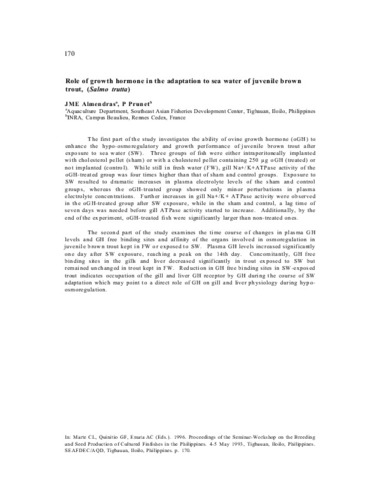Role of growth hormone in the adaptation to sea water of juveline brown trout, (Salmo trutta)
- Global styles
- MLA
- Vancouver
- Elsevier - Harvard
- APA
- Help
Share
นามธรรม
The first part of the study investigates the ability of ovine growth hormone (oGH) to enhance the hypo-osmoregulatory and growth performance of juvenile brown trout after exposure to sea water (SW). Three groups of fish were either intraperitoneally implanted with cholesterol pellet (sham) or with a cholesterol pellet containing 250 µg oGH (treated) or not implanted (control). While still in fresh water (FW), gill Na+/K+ATPase activity of the oGH-treated group was four times higher than that of sham and control groups. Exposure to SW resulted to dramatic increases in plasma electrolyte levels of the sham and control groups, whereas the oGH-treated group showed only minor perturbations in plasma electrolyte concentrations. Further increases in gill Na+/K+ ATPase activity were observed in the oGH-treated group after SW exposure, while in the sham and control, a lag time of seven days was needed before gill ATPase activity started to increase. Additionally, by the end of the experiment, oGH-treated fish were significantly larger than non-treated ones.
The second part of the study examines the time course of changes in plasma GH levels and GH free binding sites and affinity of the organs involved in osmoregulation in juvenile brown trout kept in FW or exposed to SW. Plasma GH levels increased significantly one day after SW exposure, reaching a peak on the 14th day. Concomitantly, GH free binding sites in the gills and liver decreased significantly in trout exposed to SW but remained unchanged in trout kept in FW. Reduction in GH free binding sites in SW-exposed trout indicates occupation of the gill and liver GH receptor by GH during the course of SW adaptation which may point to a direct role of GH on gill and liver physiology during hypo-osmoregulation.
The second part of the study examines the time course of changes in plasma GH levels and GH free binding sites and affinity of the organs involved in osmoregulation in juvenile brown trout kept in FW or exposed to SW. Plasma GH levels increased significantly one day after SW exposure, reaching a peak on the 14th day. Concomitantly, GH free binding sites in the gills and liver decreased significantly in trout exposed to SW but remained unchanged in trout kept in FW. Reduction in GH free binding sites in SW-exposed trout indicates occupation of the gill and liver GH receptor by GH during the course of SW adaptation which may point to a direct role of GH on gill and liver physiology during hypo-osmoregulation.
การอ้างอิง
Almendras, J. M. E., & Punet, P. (1996). Role of growth hormone in the adaptation to sea water of juveline brown trout, (Salmo trutta). In C. L. Marte, G. F. Quinitio, & A. C. Emata (Eds.), Proceedings of the Seminar-Workshop on Breeding and Seed Production of Cultured Finfishes in the Philippines, Tigbauan, Iloilo, Philippines, 4-5 May 1993 (p. 170). Tigbauan, Iloilo, Philippines: Aquaculture Department, Southeast Asian Fisheries Development Center.
Type
Conference paperISBN
9718511326
Related items
Showing items related by title, author, creator and subject.
-
Growth pattern of the tropical sea cucumber, Holothuria scabra, under captivity
Watanabe, Satoshi; Sumbing, Joemel; Lebata-Ramos, Ma. Junemie Hazel (Ministry of Tropical Agricultural Research Centre, 2014)
The growth of the juvenile sea cucumber, Holothuria scabra, was studied under captivity to elucidate the growth variation pattern and determine the best-fit growth model to estimate age- and size-specific growth rates. ...
(Ministry of Tropical Agricultural Research Centre, 2014)
The growth of the juvenile sea cucumber, Holothuria scabra, was studied under captivity to elucidate the growth variation pattern and determine the best-fit growth model to estimate age- and size-specific growth rates. ... -
Improved growth performance of Gracilariopsis heteroclada via short-term nitrogen enrichment
This study examined the effect of short-term nitrogen (N) enrichment on Gracilariopsis heteroclada growth and agar quality. Planting materials were soaked in different concentrations of ammonium chloride (NH4Cl) ... -
Growth of juvenile milkfish Chanos chanos in a natural habitat
A population of juvenile milkfish, C. chanos (Forsskaal) was studied in a small mangrove lagoon in Naburut Island, central Philippines. Several size groups of milkfish occurred in the lagoon as a result of its periodic ...






